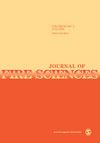纳米硅与焦磷酸哌嗪/聚磷酸三聚氰胺对聚丙烯阻燃性能的协同效应
IF 1.9
4区 工程技术
Q2 ENGINEERING, MULTIDISCIPLINARY
引用次数: 0
摘要
为了提高膨胀型阻燃剂的阻燃效率,通常需要添加纳米级助剂作为增效剂。本文研究了纳米硅与焦磷酸哌嗪/聚磷酸三聚氰胺合成聚丙烯的方法,该方法对提高聚丙烯的热稳定性和阻燃性有明显的效果。最佳增效比例为1 wt% SiO2, 10 wt%焦磷酸哌嗪,5 wt%聚磷酸三聚氰胺。该系统通过UL-94 V-1分级,极限氧指数为34.5%。峰值放热率和峰值产烟率分别降低了81%和80%。基于扫描电镜、傅里叶变换红外光谱和x射线光电子能谱的表征,对协同作用机理进行了研究。燃烧过程中SiO2与焦磷酸哌嗪/聚磷酸三聚氰胺形成反应交联网络,增强了碳保护层的结构。在膨胀型阻燃剂中,纳米硅作为发泡成核剂,在燃烧过程中促进多孔致密碳层的形成。SiO2与焦磷酸哌嗪/三聚氰胺的协同策略为设计阻燃性好、热稳定性好、放热低、发烟少的高分子材料提供了新的复合体系。本文章由计算机程序翻译,如有差异,请以英文原文为准。
Synergistic effect of nano silicon and piperazine pyrophosphate/melamine polyphosphate on flame retardancy of polypropylene
To improve the flame retardant efficiency of intumescent flame retardants, some nano-scale additives as synergists were always added. In this work, nano silicon and piperazine pyrophosphate/melamine polyphosphate into polypropylene was investigated, which was obviously efficient to improve thermal stability and flame retardancy. The optimal synergistic ratio corresponded to 1 wt% SiO2, 10 wt% piperazine pyrophosphate, and 5 wt% melamine polyphosphate. The system passed the UL-94 V-1 classification and had a limiting oxygen index value of 34.5%. It exhibited a decrease on peak heat release rate and peak smoke production rate by 81% and 80%, respectively. Based on characterizations of scanning electron microscope, Fourier-transform infrared spectroscopy, and X-ray photoelectron spectroscopy, the synergistic mechanism was investigated. A reactive cross-linking network between SiO2 and piperazine pyrophosphate/melamine polyphosphate during burning was formed to enhance the structure of carbon protective layer. Nano silicon acted as a foaming nucleating agent to promote the formation of porous dense carbon layer in intumescent flame retardants during burning. The synergistic strategy of SiO2 and piperazine pyrophosphate/melamine polyphosphate provided new compounded system for the design of polymeric materials with excellent flame retardancy, great thermal stability, and low release of heat and smoke.
求助全文
通过发布文献求助,成功后即可免费获取论文全文。
去求助
来源期刊

Journal of Fire Sciences
工程技术-材料科学:综合
CiteScore
4.00
自引率
0.00%
发文量
14
审稿时长
2.5 months
期刊介绍:
The Journal of Fire Sciences is a leading journal for the reporting of significant fundamental and applied research that brings understanding of fire chemistry and fire physics to fire safety. Its content is aimed toward the prevention and mitigation of the adverse effects of fires involving combustible materials, as well as development of new tools to better address fire safety needs. The Journal of Fire Sciences covers experimental or theoretical studies of fire initiation and growth, flame retardant chemistry, fire physics relative to material behavior, fire containment, fire threat to people and the environment and fire safety engineering. This journal is a member of the Committee on Publication Ethics (COPE).
 求助内容:
求助内容: 应助结果提醒方式:
应助结果提醒方式:


